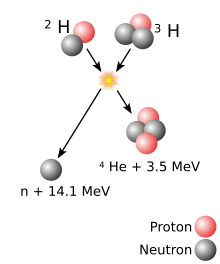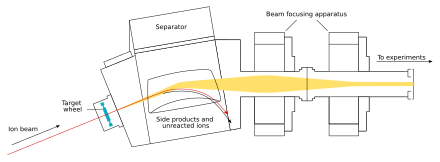Livermorium
The element is named after the Lawrence Livermore National Laboratory in the United States, which collaborated with the Joint Institute for Nuclear Research (JINR) in Dubna, Russia, to discover livermorium during experiments conducted between 2000 and 2006.
Livermorium is calculated to have some similar properties to its lighter homologues (oxygen, sulfur, selenium, tellurium, and polonium), and be a post-transition metal, though it should also show several major differences from them.
[19] The definition by the IUPAC/IUPAP Joint Working Party (JWP) states that a chemical element can only be recognized as discovered if a nucleus of it has not decayed within 10−14 seconds.
[k] The first search for element 116, using the reaction between 248Cm and 48Ca, was performed in 1977 by Ken Hulet and his team at the Lawrence Livermore National Laboratory (LLNL).
In 1985, in a joint experiment between Berkeley and Peter Armbruster's team at GSI, the result was again negative, with a calculated cross section limit of 10–100 pb.
[52] In 1995, an international team led by Sigurd Hofmann at the Gesellschaft für Schwerionenforschung (GSI) in Darmstadt, Germany attempted to synthesise element 116 in a radiative capture reaction (in which the compound nucleus de-excites through pure gamma emission without evaporating neutrons) between a lead-208 target and selenium-82 projectiles.
[54] His calculations suggested that it might be possible to make these two elements by fusing lead with krypton under carefully controlled conditions.
[54] In 1999, researchers at Lawrence Berkeley National Laboratory made use of these predictions and announced the discovery of elements 118 and 116, in a paper published in Physical Review Letters,[55] and very soon after the results were reported in Science.
[57] In June 2002, the director of the lab announced that the original claim of the discovery of these two elements had been based on data fabricated by principal author Victor Ninov.
[61][64] The observation of 289mFl in this series of experiments may indicate the formation of a parent isomer of livermorium, namely 293mLv, or a rare and previously unobserved decay branch of the already-discovered state 293Lv to 289mFl.
Whereas they found the earliest data (not involving 291Lv and 283Cn) inconclusive, the results of 2004–2006 were accepted as identification of livermorium, and the element was officially recognized as having been discovered.
Although widely used in the chemical community on all levels, from chemistry classrooms to advanced textbooks, the recommendations were mostly ignored among scientists in the field,[73][74] who called it "element 116", with the symbol of E116, (116), or even simply 116.
The city in turn is named after the American rancher Robert Livermore, a naturalized Mexican citizen of English birth.
In 2023, the reaction between 238U and 54Cr was studied at the JINR's Superheavy Element Factory in Dubna; one atom of the new isotope 288Lv was reported, though more detailed analysis has not yet been published.
[80] Similarly, in 2024, a team at the Lawrence Berkeley National Laboratory reported the synthesis of two atoms of 290Lv in the reaction between 244Pu and 50Ti.
This result was described as "truly groundbreaking" by RIKEN director Hiromitsu Haba, whose team plans to search for element 119.
In hot fusion reactions, very light, high-energy projectiles are accelerated toward very heavy targets (actinides), giving rise to compound nuclei at high excitation energy (~40–50 MeV) that may either fission or evaporate several (3 to 5) neutrons.
[88] In cold fusion reactions (which use heavier projectiles, typically from the fourth period, and lighter targets, usually lead and bismuth), the produced fused nuclei have a relatively low excitation energy (~10–20 MeV), which decreases the probability that these products will undergo fission reactions.
Hot fusion reactions tend to produce more neutron-rich products because the actinides have the highest neutron-to-proton ratios of any elements that can presently be made in macroscopic quantities.
[89] Important information could be gained regarding the properties of superheavy nuclei by the synthesis of more livermorium isotopes, specifically those with a few neutrons more or less than the known ones – 286Lv, 287Lv, 294Lv, and 295Lv.
[85] The same neutron-deficient isotopes are also reachable in reactions with projectiles heavier than 48Ca, which will be necessary to reach elements beyond atomic number 118 (or possibly 119); this is how 288Lv and 289Lv were discovered.
The cross section of this nuclear reaction would be about 1 picobarn, though it is not yet possible to produce 250Cm in the quantities needed for target manufacture.
Additionally, electron capture may also become an important decay mode in this region, allowing affected nuclei to reach the middle of the island.
A drawback is that the decay properties of superheavy nuclei this close to the line of beta stability are largely unexplored.
[85] Other possibilities to synthesize nuclei on the island of stability include quasifission (partial fusion followed by fission) of a massive nucleus.
[85] One last possibility to synthesize isotopes near the island is to use controlled nuclear explosions to create a neutron flux high enough to bypass the gaps of instability at 258–260Fm and at mass number 275 (atomic numbers 104 to 108), mimicking the r-process in which the actinides were first produced in nature and the gap of instability around radon bypassed.
[85] Some such isotopes (especially 291Cn and 293Cn) may even have been synthesized in nature, but would have decayed away far too quickly (with half-lives of only thousands of years) and be produced in far too small quantities (about 10−12 the abundance of lead) to be detectable as primordial nuclides today outside cosmic rays.
It is especially strong for the superheavy elements, because their electrons move much faster than in lighter atoms, at velocities comparable to the speed of light.
This, while an unforeseen complication, could give information that would help in the future chemical investigation of the heavier homologs of bismuth and polonium, which are respectively moscovium and livermorium.
[101] The produced nuclides bismuth-213 and polonium-212m were transported as the hydrides 213BiH3 and 212mPoH2 at 850 °C through a quartz wool filter unit held with tantalum, showing that these hydrides were surprisingly thermally stable, although their heavier congeners McH3 and LvH2 would be expected to be less thermally stable from simple extrapolation of periodic trends in the p-block.



